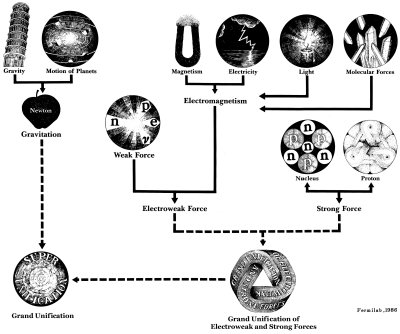 |
|
"Dear Monica..." The inquiring mind of a high school student offers a series of challenging questions for a Fermilab physicist
Monica: What exactly is this force that causes electrons to be attracted to protons, but repelled by each other?
Andreas: In the most basic theory of the force between charged objects, physicists view it as an exchange of photons. Photons are little particle-like ripples in the electromagnetic field. The idea is that an electron comes with an electric field (and, if it is moving, also a magnetic field). But this field is felt by other charged particles: we picture a photon leaving the electron and, a bit later, bumping into or being absorbed by another charge. If this other charge is the same as that of the electron, it gets pushed away. If it has the opposite charge, it gets pulled in. I’m not sure that you will be happy with this explanation, because all I have done so far is replace an incomprehensible force with an incomprehensible “electromagnetic field” and its photons.
Monica: What exactly is the state of being “negative” or “positive”? Why are there only these states (and neutral)?
Andreas: The terms “negative” and “positive” have developed partly from convention, and partly from observation. Benjamin Franklin is generally credited with originating the idea of positive and negative charges.
In experiments (including Franklin and his famous kite-flying), we have observed that various objects repel or attract each other. When these objects are combined, their total repulsion or attraction can be related mathematically. By combining the right amount of repulsive and attractive stuff, the total can end up having essentially no repulsion or attraction.
To summarize all these observations, we simply say that matter has a property that we call electric charge. An object with no repulsion or attraction corresponds to having no charge (or is said to be electrically neutral). Then, mathematically, it makes sense to assign negative values of the charge to some objects, and positive to others. That way, they can add up to zero. By historical convention, we assign negative charge to the electron. Since a proton is attracted to the electron, and since the bound state of electron and proton (a hydrogen atom) is neutral, we conclude that the proton has positive charge.
Well, once again, I am not sure that you will be happy with this explanation, because I’ve reduced to it to words that summarize a long series of observations of nature. The answer probably does not yet get at the question: “What exactly…”
Maybe a contrast will help. There is another force, called the strong force. In our most basic theory of the strong force, called chromodynamics, there is a property (again, summarizing lots of observations) that is in some ways like charge. But instead of having two aspects (positive and negative), it has three aspects. If you combine the same amount of all three aspects, the total behaves in an essentially neutral way. We particle physicists call this corresponding property “color.” It’s a playful analogy with ordinary colors: if you combine the same amount of blue, red, and green light, you get white light. Everything bigger than a proton is colorless, but some particles called quarks, inside protons, do have color.
Monica: To put it concisely, what exactly IS a charge? How does such a thing exist, and why does it cause objects to interact the way they do?
Andreas: Unfortunately, it is hard to answer “what exactly” questions. Science does not work in that way. Rather than striking at the core, we peel off layers. In the case of charge, we start by watching objects move. We notice that the motion is more complicated than would be explained by gravity and by manual pushing. So we say there is an electric force. Then, in deducing the force law (Coulomb’s law), it is convenient to introduce electric charge: it is easier to remember the electron’s charge, and Coulomb’s law, than to memorize the whole pattern of motion.
We move on from electric forces to electric and magnetic fields, again because the fields, which are more abstract, allow us to forget more details of real observations. For example, it is a lot easier to predict the properties of electrical circuits and electric motors by using the field concepts. Finally, it is a lot easier to understand the details of the electron’s behavior with the concept of the photon.
If you think about peeling off one layer at a time, the amazing thing about physics is this: from each inner layer, we can reconstruct all the layers farther out, without having to repeat everything that enabled us to understand the outer layers at the start. But we can understand nature very well— in the sense of making precise predictions about what will happen—without knowing all about the layers farther in.
Let me give an example: Some books and articles say that Einstein “proved Newton wrong” by finding a better law of gravity. Actually, Einstein found the next layer of understanding. Newton’s law of gravity is still good enough for NASA to use it in guiding spaceships through our solar system and beyond, and even have them land on the moon (which required very fine control). Similarly, many theoretical physicists are trying to figure out the next layer farther in from Einstein’s.
At Fermilab, and a few other leading research labs, we are trying to get from the so-far innermost layer of understanding to the next ones farther in. Asking, “what’s next?” is less philosophical than “what exactly…” but it turns out to be exciting and challenging enough, and also more successful.
Monica: I am afraid that I have yet another question. The websites that I visited said that the strong force holds the nucleus together. I understand how the strong force binds the quarks together. What I didn’t see in these explanations was an explanation of whether the strong force also affects quarks in the other protons or neutrons within the nucleus.
Andreas: It is the same strong force. The strong force binding protons and neutrons together into a nucleus is a residue of the even stronger force among the quarks. The same phenomenon occurs with molecules, but in that case, it stems from electromagnetic forces. In chemistry, you may have heard of “van der Waal’s forces.” These forces are the residue of electromagnetic forces binding electrons to the nuclei within the molecules.
Monica: Do quarks that are already confined in hadrons exchange gluons with quarks in different hadrons? [Hadrons are particles made of strongly-interacting constituents (quarks and/or gluons). Gluons are the carrier particles of the strong interaction—Ed.]
Andreas: Yes, they do. But the gluon exchanges of quarks within a single hadron tend to cancel each other out. So if a neutron and a proton are almost on top of each other, the force is still quite strong; but if they are far apart, the force between them almost vanishes. Again, van der Waals forces act in the same way; they, too, are quite short range in their effect.
Additionally, the quarks themselves have different electrical charges, and are confined (despite these opposite charges) because the strong force is much more powerful than the electromagnetic force. This being the case, do quarks in different subatomic particles feel attraction to each other? Basically, they do: the strong force among quarks is about 40 or 50 times stronger than the electromagnetic force among them. If the charges are the same (like the two up quarks in a proton) the electromagnetic force trying to push them apart is overwhelmed by the strong force holding them together.
Monica: So could a positive quark in a proton be attracted to a negative quark in a different proton?
Andreas: Yes. In this case both the strong and electromagnetic forces are attractive. But, you also have to add up all the forces from all the quarks. Thus, consider two protons. If they are far apart, all the strong forces basically cancel out, and you are left with the repulsive electromagnetic force of two charges. If they are close together, the net strong force is still pretty strong. Not quite strong enough to bind them, but if you put one neutron and two protons close together, they will bind into the helium-3 nucleus.
Monica: Thanks for reading and answering these emails! If I were to work in a field such as particle physics, I would definitely want to be part of the discoveries. I sometimes worry about the math, but if I decide that particle physics is for me, I will have had the equivalent of three years of calculus before entering college. I think I will be a lot more comfortable with math in general by then.
Andreas: I find it encouraging that you would prefer to be part of the action. The way to become strong in math is through practice. The same principle applies to athletics, where you don’t learn the high jump from reading books about it. Talent helps, instruction helps, and books help. But practice makes perfect.
Ben Franklin: The Plus and Minus
“In one of his first letters, Franklin supplied a novel terminology that became standard in analyzing electrical phenomena. Describing a particular apparatus, consisting of bodies labeled A and B, he wrote: ‘We say B (and other bodies alike circumscribed) are electrised positively; A negatively. Or rather B is electrised plus and A minus.’ …At a time when other electricians spoke of two different kinds of electricity—vitreous and resinous—Franklin unified the field by positing a single sort and explaining the opposite properties in terms of a surfeit or a deficit (that is, positive condition or negative) of this single electricity, with uncharged objects being in balance.”
|
 Questions about physics pop up continually through the Fermilab website, but some exhibit a level of engaging curiosity that sets them apart and begins an extended dialogue of questions and answers. Monica Charpentier, a junior at Dulaney High School in Timonium, Maryland submitted a question about the property of charge. “Just what is it?” she wanted to know. Her query found its way to Fermilab theorist Andreas Kronfeld, who welcomed the opportunity to follow her questions and insights to succeeding levels of complexity.
The dialogue begins with Monica’s original question in her first email…
Questions about physics pop up continually through the Fermilab website, but some exhibit a level of engaging curiosity that sets them apart and begins an extended dialogue of questions and answers. Monica Charpentier, a junior at Dulaney High School in Timonium, Maryland submitted a question about the property of charge. “Just what is it?” she wanted to know. Her query found its way to Fermilab theorist Andreas Kronfeld, who welcomed the opportunity to follow her questions and insights to succeeding levels of complexity.
The dialogue begins with Monica’s original question in her first email…

 From “The First American: The Life and Times of Benjamin Franklin,” by H.W. Brands, here is a description of Franklin’s ongoing correspondence begun in 1747 with Peter Collinson in London. Collinson was an agent of the Library Society of Philadelphia, and a scholar with scientific interests similar to Franklin’s:
From “The First American: The Life and Times of Benjamin Franklin,” by H.W. Brands, here is a description of Franklin’s ongoing correspondence begun in 1747 with Peter Collinson in London. Collinson was an agent of the Library Society of Philadelphia, and a scholar with scientific interests similar to Franklin’s: